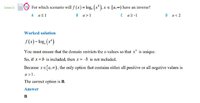You are using an out of date browser. It may not display this or other websites correctly.
You should upgrade or use an alternative browser.
You should upgrade or use an alternative browser.
Graphs of Logarithmic Functions
- Thread starter eutas1
- Start date
Dr.Peterson
Elite Member
- Joined
- Nov 12, 2017
- Messages
- 16,088
They are asking how to restrict the function's domain so that its inverse is a function -- that is, so that the restricted function is one-to-one.I don't understand the question or the worked solution...
It will not be one-to-one if there are two values of x in the domain that yield the same value for f(x). That will happen if some value x and its negative -x are both in the interval. To prevent this, a must be positive, and the only choice in the list that ensures that is (b). In fact, as long as b > 0 it would work.
Steven G
Elite Member
- Joined
- Dec 30, 2014
- Messages
- 14,383
I would look at it slightly differently.
f(x) = log (x4) = 4log |x|. It should be clearis clear that for example, f(-7) = f(7) which prevents f(x) from being 1-1 unless we restrict the domain. Since it must be (a, inf), we must have a>0. This is true only for choice b.
f(x) = log (x4) = 4log |x|. It should be clearis clear that for example, f(-7) = f(7) which prevents f(x) from being 1-1 unless we restrict the domain. Since it must be (a, inf), we must have a>0. This is true only for choice b.
They are asking how to restrict the function's domain so that its inverse is a function -- that is, so that the restricted function is one-to-one.
It will not be one-to-one if there are two values of x in the domain that yield the same value for f(x). That will happen if some value x and its negative -x are both in the interval. To prevent this, a must be positive, and the only choice in the list that ensures that is (b). In fact, as long as b > 0 it would work.
I can understand that the domain cannot contain negative values, because this would then produce TWO y-values --> therefore it is NOT a one-to-one function which means NO inverse function. But doesn't that mean 'a' should then be any positive number, therefore a > 0 ??? So can't the answer be (a), (b), and (d) since they are all positive?
I would look at it slightly differently.
f(x) = log (x4) = 4log |x|. It should be clearis clear that for example, f(-7) = f(7) which prevents f(x) from being 1-1 unless we restrict the domain. Since it must be (a, inf), we must have a>0. This is true only for choice b.
If you do f(x) = log (x^4) =4log(x) , then wouldn't that mean x > 0 ? So then the answer would be (A), (B), and (D) ?
Dr.Peterson
Elite Member
- Joined
- Nov 12, 2017
- Messages
- 16,088
Read the problem very carefully. It says this:I can understand that the domain cannot contain negative values, because this would then produce TWO y-values --> therefore it is NOT a one-to-one function which means NO inverse function. But doesn't that mean 'a' should then be any positive number, therefore a > 0 ??? So can't the answer be (a), (b), and (d) since they are all positive?
It is not asking for the largest possible domain over which the function is one-to-one; it is asking WHICH of the four options will always lead to A possible domain. Also, it is not saying that \(a>1\) is the domain; it is saying that \([a,\infty)\) is a domain over which f would be one-to-one, for any value of a greater than 1. Yes, a can be any positive number; but that is not what they are saying.
If \(a\le 1\), that allows a to be negative, e.g. \(a = -1\), in which case the domain would be \([-1,\infty)\), and f would not be one-to-one.
The same is true for \(a\ge -1\), and for \(a<2\).
Read the problem very carefully. It says this:
View attachment 26338
It is not asking for the largest possible domain over which the function is one-to-one; it is asking WHICH of the four options will always lead to A possible domain. Also, it is not saying that \(a>1\) is the domain; it is saying that \([a,\infty)\) is a domain over which f would be one-to-one, for any value of a greater than 1. Yes, a can be any positive number; but that is not what they are saying.
If \(a\le 1\), that allows a to be negative, e.g. \(a = -1\), in which case the domain would be \([-1,\infty)\), and f would not be one-to-one.
The same is true for \(a\ge -1\), and for \(a<2\).
OH! I misread the '<' signs as '>' so that's why I was confused... my bad! Thank you very much

